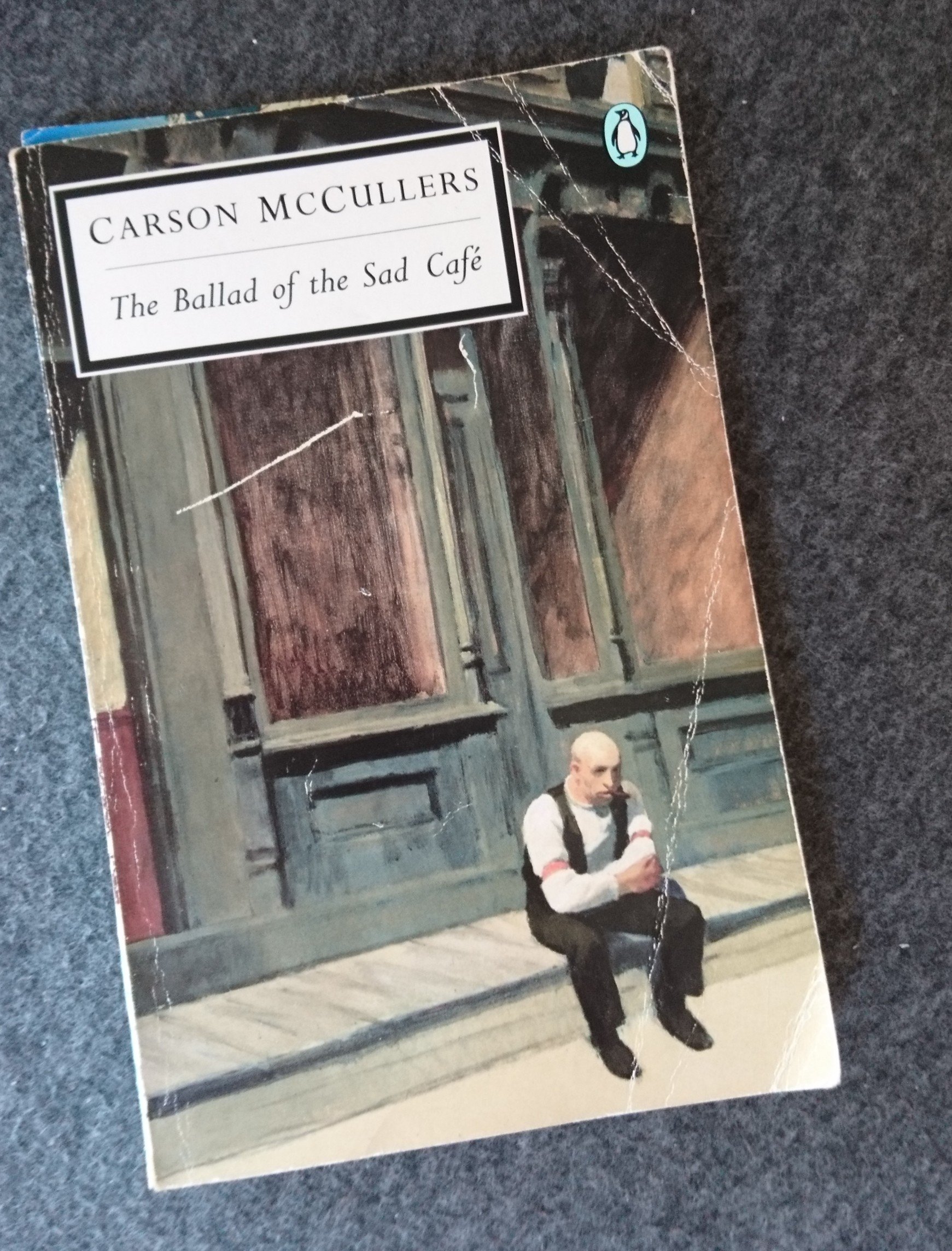
The cover is scarred and dog-eared, but no matter. I fall on it with delight, hand over my change, squirrel it away to peruse at leisure. Pre-owned or pre-loved but then discarded, I hope to offer it affection in my turn. I scurry home to begin the conversation.
But what’s this I see?

The indelible tattoos of ownership are all over the title story. Neatly ruled lines in red, blue and black disfigure the pages. Glyphs — of hearts, clock faces, asterisks, a cross, even a supine stick figure — patrol the margins. Emphatic verticals hem in selected paragraphs. An ex-lover has sought to control the text, constrain with chains of interpretation, explain what the author meant rather than let her speak her own mind.
I had hoped to form a personal relationship; I’m now confronted with an abused entity. It will be difficult, almost impossible, to form my own impressions, to establish an open dialogue, to enjoy the proffered delights with total innocence.
But then I pause, and reflect. When I’ve had my way will it not be likely that I too will abandon this mistress of the moment? Will I not publicly discuss her strengths and failings? Will I not foist my own interpretation on her thoughts, discuss her form, palm her insights off as my own?
Though I will never mark her with own brands will I not, in my turn, also be an inconstant lover?

I really enjoyed this post – great job!!!
It’s funny this issue of marking books. When I was doing A’levels and at University I wrote all over my textbooks, correcting errors (according to my lecturers) and adding examples and references. The books became as much my own notes as they belonged originally to the author(s). It was a lot like the Half-Blood Prince’s book in J Rowling’s Harry Potter book of a similar name. That said I would hate to mark a book of fiction like that, unless, unless, something in it touches my soul. Perhaps you know the feeling where a book puts into words something you’ve known but been unable to name for years and finally you have words for it. When that happens it doesn’t matter that they’re not my own words, they get woven into me somehow. Then I lightly draw a vertical line in pencil at the side of the paragraph and usually put a small piece of paper in there so I can find it again. Then, later, I copy it into my journal and rub out the pencil line.
I also have a love of second hand books. It’s like finding a diamond for 25p that someone has thrown away. But I do generally avoid books with markings all over the text.
LikeLiked by 1 person
You are a student after my own heart, Jo! Like you I love finding a secondhand book I had almost despaired of ever discovering—but this title, unusually for me, I didn’t check before purchasing. Would I have passed on it if I’d known it had been marked? Hard to say, I’d never come across it before (or even since) so the question’s sort of hypothetical.
Like you I tend to scribble observations in a notebook, always have, even as a student. The printed text for me is sacrosanct, I even hate clipping articles out a newspaper. Only a handful of times have I pencilled a faint vertical line by a passage, and have always felt it was a form of sacrilege.
LikeLike
An insightful post 🙂 I too am wary of any markings in a book – if I buy a used book, I always make sure there are no markings in it… I do make a lot of annotations and write down quotes, but never in a book. It needs to stay clear for me so that I can form my own opinion of it and choose my own important messages 🙂
LikeLiked by 1 person
Everything you say, Ola, chimes with my feelings, especially the forming of one’s own opinion. And if the book has been massively disfigured I reject it, exactly as you would.
LikeLiked by 1 person
Being a bookworm is a tough vocation, isn’t it, Chris 🙂 I do like a used book, with creased spine and yellowed pages, but I can’t stand a disfigured, as you say, book. It smacks of carelessness and indifference of the previous reader, and makes me inexplicably sad on behalf of the damaged book 😉
LikeLiked by 1 person
Yes, exactly, Ola! A well used book is fine, an abused is not.
LikeLiked by 1 person
I find the markings sort of fascinating – do they seem to be scholarly or somehow personal? I wonder what the symbols mean, whether the scribbler had their own Key to them. I totally agree, I would feel distracted when reading this too, but still the markings are interesting. Probably a story there! Beautifully written post Chris
LikeLiked by 1 person
I’m guessing they’re made by a former literature student, either from lecture notes or because she/he (though I suspect she) was given an assignment to discuss aspects of love, time, death and so on and has then marked up all related passages in different inks as a colour code. Red, I think, relates to Love…
Anyway, glad you liked the post, Lynn, a bit more lyrical than is my wont!
I do so love all those similar words related to writing: scribble, scribe, scribbler, scrivener, script, nondescript, inscribe, describe, escriptoire, scripture, and the Welsh for ‘writer’, ysgrifennwr…
LikeLiked by 1 person
What a lovely love list of words! 🙂
LikeLiked by 1 person
I’m conflicted when it comes to writing in books. I do annotate text books for work to enable me to find the relevant information quickly but avoid it in fiction (and work unrelated non-fiction). However, I love finding discreet annotations by my relatives in books I have inherited so in principle I don’t mind it as long as it doesn’t over-shadow the text (so a penciled footnote or vertical line is fine but if it is more it starts to intrude). Of course notes made by people I love are much more welcome than comments made by strangers…
LikeLiked by 1 person
I think I’m less conflicted than I used to be, Johanna, especially if I go by the W questions:
Who? It’s interesting if the author or an academic has annotated a text, good for historical or scholarly reasons, but not if it’s somebody who habitually writes on toilet doors or tags all over somebody’s excellent street art; to me that’s like a dog marking its territory.
What? I’m as irritated with unsupported comments like ‘Rubbish!’ as I am with book reviews that simply read ‘Meh’. Maybe if a reference had been added, for example, I’d have been a little mollified.
Where? Annotations that obscure the original text, or bleed through the page and disfigure the observe are anathema to me. Marginalia are more acceptable than scribbles between the lines, but only just.
When? Those glosses on medieval manuscripts, where would scholars be without them? The elucidations, the additional information, the cleric’s doodle, all invaluable. But in a modern printed book, from a library? Unacceptable: write a paper for a journal if you must, be a scribe, not a scribbler…
How? Pencil, just about okay. Ink, felt tip, highlighter? No way, unforgivable.
Why? That’s the question only scribblers can answer. Can they ever justify the practice? I doubt it.
There, always good to get a rant off my chest! And yes, nice to read the ‘discreet annotations’ by loved ones—a bit of family or personal history, I wouldn’t mind that. 🙂
LikeLiked by 1 person
Yeah, if it were not for those annotations by loved ones I would have been against all types of writing but now I have to ask myself if there is any chance that some of my books might end up with someone who would be happy to have a bit of family history preserved. I’m not annotating now (except in text books when I need it) and if I ever do it will be very discreetly and rarely, but I haven’t entirely excluded the possibility. If so the notes would most likely be related to family history, e.g. to indicate a poem chosen for a family wedding or funeral etc.
LikeLiked by 1 person